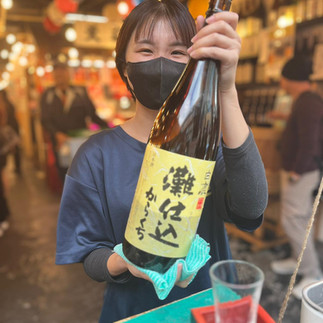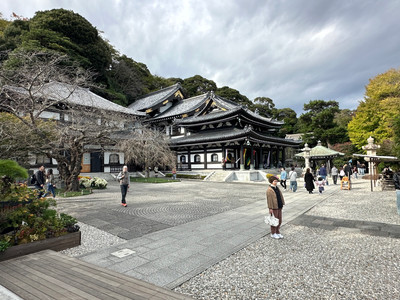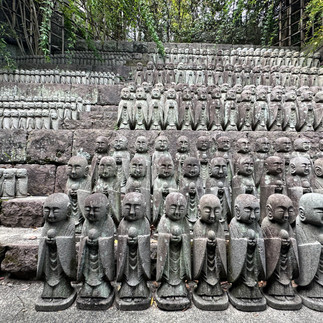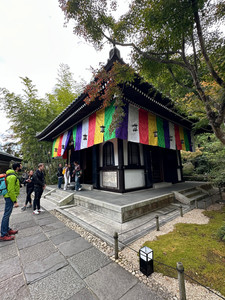Tokyo Day Trips to surrounding areas of Kanagawa
- sinjahaag
- 11. Jan.
- 18 Min. Lesezeit
Aktualisiert: 10. März
Tokyo is the hub for a variety of wonderful day tours one can take advantage of. In this article, I will share the experiences I made regarding three day trips of my own to Yokohama, Kamakura, Enoshima and Hakone, all situated in Prefecture of Kanagawa, south of Tokyo. Get to know more about these places, things to do and decide for yourself whether it's worth a visit!
Cup Noodles Museum
Red Brick Warehouse & Chinatown
Yokohama
Yokohama is Japan's second largest city (did you know that? I was sp surprised!) offering a great blend of urban sophistication with modern architecture and districts, cultural diversity, historical sites and a calming seaside charm. It's a perfect day trip getaway from Tokyo, easily reachable via train, which only takes you 30min. one way!
Cup Noodle Museum
"Peace will come to the world when there is enough food" - Momofuku Ando
Yokohama Cup Noodle museum displays an interactive exhibition of the life of Momofuku Ando (1910–2007), a Taiwanese-Japanese inventor, entrepreneur and creator of the world's famous instant noodles.
Motivated by post-World War II food shortages in Japan, Ando aimed to develop an affordable, easy-to-cook, and long-lasting meal. After months of experimentation, he firstly introduced the concept of Chicken Ramen in 1958; a pre-cooked, dehydrated noodle product that could be prepared by solely adding hot water. 14 years later, he further revolutionized global food culture by launching Cup Noodles; product packaged noodles in a disposable foam container, which served as both a cooking and eating vessel, ensuring portability and ease of use. Ando famously said, "Peace will come to the world when there is enough food," reflecting his belief in the power of accessible food to solve global challenges. His work has left an enduring legacy, with instant noodles recognized as one of the 20th century's most impactful inventions. The museum reflects on his personal life, challenges, creative ideas and characteristic ways of thinking in an illustrative, educational and immersive format that will hold new surprising insights for both adults and children! Did you know, for instance, that a ramen creation for space & aviation, called "Space Ram", exists?
Museum Features:
Chicken Ramen Factory:
Put yourself in the shoes of young Momofuku and create your own chicken ramen via hands-on-learning courses in kneading, spreading, steaming and seasoning wheat flour to consequently dry it with the so-called flash frying method (reservation required!)
My CupNoodles Factory:
Create your own Cup Noodles by putting together your own design, noodle type & flavour as well as topping variation (reservation required, best to purchase online beforehand!). Opening hours are 11am - 6pm.
My CupNoodles Park:
Become a Ramen noodle and immerse into the loop-process experience of purchasing, manufacturing and customer shipment.
Instant Noodles History Cube:
Marvel the plentiful variations of internationally existing cups and flavours of instant noodles which arose from the single idea and launch of Chicken Ramen back in 1958
Momofuku's Theatre, Work Shed & Story:
Read, watch and see Momofuku's road to glorious inventions from the very beginning to the end of his lifetime.
Noodles Bazaar:
Try one, two or three differing noodle variations at the World Noodles Road, inspired by Momofuku's travel encounters on a total of 8 different noodle types in the atmosphere of an Asian night market. Opening hours are 11am - 6pm.
Museum Shop:
Pick a nice noodle-related gift to take home with you.
Practical Information
Location:
2-3-4 Shinko, Naka Ward, Yokohama, Kanagawa Prefecture.
Access:
from Yokohama Station, take the Minatomirai Line to Minatomirai Station or Bashamichi Station. The museum is about a 10-minute walk from either station.
Opening Hours:
daily from 10:00am to 6:00pm (last entry at 5:00pm). Closed on Tuesdays & New Year holidays
Admission Fee:
Museum entry is 500JPY per person; free for children under 12 years of age.
My Cup Noodles Factory entry is 500JPY per cup.
Chicken Ramen Factory is 1.500 - 1.800JPY per session.
Red Brick Warehouse & Chinatown
If you have a spare minute prior to- or after the cup noodles museum, I highly recommend visiting Yokohamas port sight, where you'll find the Red Brick Warehouse, also known as Yokohama Akarenga Soko. It's easily reachable via train or a 30min walk from the museum site.
Originally serving as customs inspection house for boats & shipments in former days, the Red Brick Warehouse nowadays serves as lively community- and culture centre hosting several stores, market halls, exhibitions, art crafts and cafe- and restaurant options. If you are lucky, you will directly bump into an outdoor market/festival with plenty of smaller stands selling craft beers, arts, jewellery & hand crafts, hot dogs, paired with live music. Take a moment to relax in the surrounding greenery area to observe ships passing by and enjoying the scenery along the water.
End your day with eating your way through some delicious snacks & dishes in Japan's largest Chinatown and make your day a perfect wrap!
Practical Information
Red Brick Warehouse: how to get there
By Train:
6 minutes’ walk from Bashamichi Station or Nihon-odori Station (Minato Mirai Line).
15 minutes’ walk from Sakuragicho Station (JR Negishi Line or Yokohama Subway).
By Bus:
Take the Akai Kutsu Loop Bus, a tourist bus that stops at major Yokohama attractions.
By Car:
Parking is available but may be crowded during events.
Chinatown: how to get there By Train:
Motomachi-Chukagai Station (Minato Mirai Line): 2-3 minutes’ walk.
Ishikawacho Station (JR Negishi Line): 5-10 minutes’ walk.
By Bus:
The Akai Kutsu Loop Bus stops near Chinatown.
By Car:
Several parking lots are available, though they may be crowded during weekends or events
Kamakura
Kamakura is a historic city in Kanagawa Prefecture, renowned for its rich cultural heritage, temples, and beautiful coastal scenery. Due to its historical significance as ancient political and cultural center of Japan during the Kamakura period (1185–1333), it is often referred to as "Kyoto of Eastern Japan". As the area is quite large, you will most likely not be able to cover the most iconic sightseeing spots by yourself self-guided in one day. Herefore, I highly recommend booking a day trip tour by bus, e.g. via klook, GetYourGuide, Viator or other travel service providers. If you have more time at-hand, it makes sense to spend some days in Kamakura to explore the area at your own pace and time to also discover further, less touristic spots, that most guided tours leave out.
Things to Do & See:
Kotoko-in Temple: The Great Buddha of Kamakura (Kamakura Daibutsu)
Kotoko-in Temple is home to one of Japan's most famous Buddha statues and landmark of Kamakura, the Great Buddha of Kamakura. A massive bronze statue of Amida Buddha (central figure in Pure Land Buddhism symbolising enlightenment, compassion & eternal peace) that hold an interior for visitors can enter. Originally constructed in the 13th century, the statue was initially housed inside a large temple hall, which was destroyed multiple times by typhoons and earthquakes. Since the late 15th century, the statue has stood in the open air.

Practical Information
Address: 4-2-28 Hase, Kamakura, Kanagawa Prefecture.
How to get here: From Hase Station (Enoden Line), walk 10-minutes .
Opening Hours: daily from 8:00am to 5:30pm (last entry at 5:00pm).
Admission Fee: around 300JPY. Additional 20JPY to enter the interior of the statue.
Tsurugaoka Hachiman Shrine
Kamakura Tsurugaoka Hachiman is one of the most historically significant and iconic Shinto shrines in Japan. It was established in 1063 and moved to its current location in 1180 by Minamoto no Yoritomo, first Samurai Shogun of Kamakura and founder of the Kamakura Shogunate. Reason for the shrines re-location was a matter of safety: three sides of the shrine are surrounded by wooden mountain area, whereas the fourth side faces the sea, making it difficult for enemies to attack. The shrine is dedicated to Hachiman, the patron deity of warriors, who is also considered the guardian of the samurai. The area features a grand staircase, a lovely approach lined with cherry trees (Dankazura), and scenic lotus ponds.
Komachi Street (Komachi-dori)
Komachi Street is a vibrant shopping street, located just outside the exit of Tsurugaoka Hachiman. It is a popular tourist hot spot that easily gets crowded towards noon, famous for its street food stands (especially fish), restaurants, souvenir shops and boutiques.
Local specialties to go for and try:
Senbai (rice crackers): if you come from Europe, you might be familiar with so called "Asia Weeks" in Supermarkets, where mixed rice cracker bags are being sold both in sweet and savoury flavours. These ones are just alike. Grab your favourite snack mix for the small hunger in between.
Shirasu (whitebait fish): now, this is probably one of the most bizarre and unusual dishes you will come across; at least it was for me- at first glance, you might think you are looking at a bowl of rice but taking a closer look makes you realize that you are spotting a little hill of immature baby fish, mostly baby sardines, silvery-white in color. These can come either dried or blanched. I have not had the chance to taste them, as I was too busy trying sake, unagi and oysters but if you do have a chance, I'd be curious to hear your feedback!
Tako Senbei (crispy octopus crackers): fresh or wrapped as a souvenir. These usually have the size of my head and are a beloved snack of locals to be enjoyed.
Curry Bread: deep-fried buns with Japanese curry filling. Trust me on this by saying that these freshly fried buns taste absolutely different than your store-bought convenience ones!
Dango (sweet rice dumplings): chewy and rich in texture, these rice dumplings usually come on a skewer with a glaze of sweet soy sauce
Sake: is poured for tastings in several places for 100JPY only. Enjoy a glass to try paired with your meal!
Practical Information
Opening Hours: around 10am - 6pm (opening hours may vary depending on vendors and shops)
How to get here from Kamakura Station:
Komachi Street is a 1-minute walk from the station's east exit.
How to get here from Tokyo:
Take the JR Yokosuka Line from Tokyo Station to Kamakura Station (approx. 1 hour).
Hasedera Temple
The legend of Hasedera says that around 1300 years ago two sculptors carved two Kannon statues out of a sacred tree. One Kannon, the Goddess of Mercy, was enshrined in Hasedera, whereas its counterpart is located in Nara. The over 9 meters tall Goddess is commonly referred to as "Eleven-deaded Kannon" due to her eleven heads on top of her own head, each representing different aspects of compassion.
As located on top of a hill, the temple offers breathtaking panoramic views, which are told to be the most beautiful sights one can get from Kamakura. There is also a short beautiful oceanview path to walk for further panoramic pictures.Surrounded by large garden areas, Hasedera additionally offers a blooming spectacle in warmer months, such as June or in spring.
Next to the Kannon, panoramic and garden views, you will wind beautifully lined up Jizo statues, dedicated to Jizo Bosatsu, the protector of children, travelers, and the deceased. Thousands of small Jizo statues are placed here by visitors in memory of lost children.
Hungry? Take a stop at Kaikoan, Hasedera's restaurant and resting area. Traditional snacks and sweet treats are being served and right across the restaurant you will spot a Hall, containing "Mani- Guruma" (prayer wheels, also referred to as "wheel of laws" in Tibetan), cylindric objects holding several sutras inside, whose merit you can earn by turning them. Located in the center of these Mani Guruma, an octogonal stack, called "Rinzo" is located. It can be turned on every 18th day of each month, letting you earn all the merit as from reading all the sutras.
Last but not least, take a walk through the cave Benten-kustu, featuring carvings of Benzaiten, goddess of music, arts, and prosperity, along with other Buddhist figures. The cave itself is very narrow and dark and most parts need to be discovered in a crouching posture. Candles can be lit as offerings.
Practical Information
Location: 3-11-2 Hase, Kamakura, Kanagawa Prefecture Admission: 400JPY
Opening Hours:
March - September: 8:00am - 5:30pm
October - February: 8:00am - 5:00pm
How to get there from Kamakura Station
By Train:
Take the Enoden Line to Hase Station (5 minutes).
The temple is a 5-minute walk from Hase Station.
By Bus:
Take a bus from Kamakura Station bound for Hase and get off at the Hasedera stop.
Island of Enoshima
Enoshima Island is a small, enchanting island in Kanagawa, belonging to Fujisawa City. It is connected to the mainland by a bridge and mainly known for its shrines, scenic viewpoints & delicious seafood. The island is basically divided into two parts: a front yacht harbor and a forested hill. In summer, Enoshima is a great destination for a beach and swim-, sailing- or boat session. During autumn and winter it can get quite rainy and windy, so be prepared to take a rain cape and some solid shoes when visiting the little island! The main attraction, next to food, which is always my favourite thing to explore, is Enoshima Shrine, a series of three differently located shrines around the island dedicated to Benten, goddess of fortune, wealth, music and knowledge.
Enoshima Shrine & Sea Candle
Enoshima Shrine consists of three shrines: Hetsunomiya (located near the entrance), Nakatsunomiya (situated halfway up the hill) and Okutsunomiya (at the island’s back end). To get to the shrines you will have to walk a lot of stairs, surpassing plenty of souvenir- and food stores along the way. Alternatively, you can take a stairway lift taking you to each level of the shrines (approx. 1100JPY).
Reaching the top of the hill offers you a beautiful view over the ocean, accompanied by beautiful greenery and Japanese gardens. Here, you also have the chance to visit the 360 degree- oberservation desk "Enoshima Sea Candle" (admission 500JPY), a lighthouse tower from which you can overlook Enoshima Island and the ocean from above. At night, you might also experience beautiful garden illuminations. Close-by attractions are "Samuel Cocking Garden" (admission 500JPY after 5pm), a botanical garden originally developed by the British trader, Samuel Cocking, in the 19th century, showcasing seasonal flowers and the two natural "Iwaya Caves" (admission 500JPY), dedicated to the legend of Benten and a sea dragon.
Practical Information
How to get there from Tokyo:
Take the JR Tokaido Line or Odakyu Line to Fujisawa Station, then transfer to the Enoden Line to Enoshima Station.
From Kamakura:
Take the Enoden Line directly to Enoshima Station.
By Car:
Drive to Enoshima and park at one of the mainland parking lots near the bridge.
By Bus:
Local buses connect nearby areas like Fujisawa and Kamakura to Enoshima.
Further Sightseeing Spots to take into consideration
Engaku-ji Temple: one of Kamakura's five great Zen temples (Kamakura Gozan), known for its peaceful atmosphere and historic Shariden Hall, a National Treasure.
Zeniarai Benzaiten Shrine: a small but unique shrine where you can "wash" your money in sacred spring water. By doing so, it is believed to multiply your wealth.
Kamakura Beaches: popular beaches like Yuigahama and Zaimokuza are ideal for relaxing and surfing.
Hakone
Hakone is a mountains town in the Prefecture of Kanagawa, famous for its hot springs, art museums and beautiful nature scenery with beautiful sights of Mount Fuji on cloudless days! The area offers a range of popular tourist attractions, such as Hakone Shrine & Torii Gate, Hakone Ropeway, the volcanic village Owakudani, UNESCO World Heritage site Obuno Hokkai and a total of five lakes surrounding Mount Fuji with stunning landscapes and calming atmospheres.
Things to Do & See:
Hakone Shrine & Lake Ashinoko (Lake Ashi)
Located at the southern shore of Lake Ashi (Ashinoko) in Hakone, Hakone Shrine is one of the most famous Shinto shrines to visit, being surrounded by cedar forests with a marvellous view onto Lake Ashi and even Mount Fuji on clear days. It is dedicated to the deities of Mount Hakone, who are said to protect travellers and ensure safe journeys. It is also associated with legends of a nine-headed dragon (Kuzuryu), which is believed to inhabit Lake Ashi. The nearby sub-shrine, Kuzuryu Shrine, honors this mythical creature.
The shrine main grounds of Hakone Shrine can be reached via a lantern-paved stairway, including smaller shrines along the way through peaceful greenery. On the bottom, right next to the parking lots for both cars and buses, you will find restrooms and a small kiosk for drinks & snacks.
The most iconic feature about Hakone Shrine is its red Torii Gate, referred to as Heiwa no Torii (Torii of Peace), right by the water of Lake Ashi. From Hakone Shrine you simply walk towards the water and cross the street, where Torii Gate is signposted to follow a short path along. This is a popular tourist destination and one of the most photographed landmarks in Hakone. Taking a picture might be difficult to manage, depending on your point of arrival, as a long queue keeps lining up in front of the Gate, requiring you to get in line to wait.
Practical Information
Location: Hakone Shrine is located near Moto-Hakone, on the southern shore of Lake Ashi.
How to get here from Tokyo:
By train: take the Odakyu Romancecar to Hakone-Yumoto Station. From there, buses or sightseeing boats on Lake Ashi lead to Moto-Hakone.
By cable car or boat: Hakone Ropeway and boat cruises also connect the area.
Opening Hours: open daily for 24/7, though the main shrine office operates from 9:00am to 5:00pm.
Admission: free to visit, though donations are appreciated for upkeep.
Lake Ashi Pirate Ships & Hakone Ropeway
Aarrrgh! Not far away from Hakone Shrine, you will find another fun thing to do: pirate-themed cruise offerings. These boats take you on a scienic tour around Lake Ashi in a Pirates of the Carribbean feelings, equipped with colourful decorations, masts and sails. It's a great and fun way to explore the lake and its surrounding nature, including views onto Hakone's Torii Gate, Mount Fuji (if you are lucky) and the beautiful nature surroundings. In total, three providers are at-hand to choose from: Royal II, Victory and Queen Ashinoko. Each boat operates between Motohakone Port, Hakonemachi Port and Togendai Port every 30 - 40min, so you can easily jump on- and off to make your way around. A full cruise takes around 30min. only. If you are keen to take the famous Hakone Ropeway, you need to get off at Togendai Port.
Practical Information
Operating hours:
From 9:00am to 5:00pm (seasonal changes may apply)
Admission:
One-Way Ticket: approx. 1.200JPY (Adults), 600JPY (Children).
Round-Trip Ticket: approx. 2.200JPY (Adults), 1,000JPY (Children).
Tickets can be purchased at the ports or online.
From Togendai Port follow the crowds to Hakone Ropeway, a scenic cable car, covering the most beautiful areas of Hakone from a birds eye view: Laki Ashi, Mount Fuji and Owakudani. As by now, you probably have already seen Hakone Shrine, the Torii Gate as well as passing Lake Ashi to get here by boat, the next destination you want to go for is Owakudani, the volcanic village.
Hakone Ropeway covers four stations: (1) Sounzan, (2) Owakudani, (3) Ubako, (4) Togendai. Tickets can be ourchased for the entire route (roughly 30min. one way) or to individual stops. The gondola itself is very spacious and offers great viewing opportunities to each side. Going up, you might, again, have a good spot onto Mount Fuji if you know which direction to look at (I didn't, of course...).
Practical Information
Operating Hours:
daily from 09:00am - 04:00pm (seasonal changes may apply)
How to get there from Tokyo
By Train:
Take the Odakyu Romancecar from Shinjuku to Hakone-Yumoto.
Transfer to the Hakone Tozan Train to Gora, and then take the Hakone Tozan Cable Car to Sounzan Station, the starting point of the ropeway.
By Bus:
Express buses from Shinjuku or Odawara can also connect you to the Hakone Ropeway.
Owakudani
Owakudani, also referred to as "Great Boiling Valley", is a volcanic valley located in Hakone, renowned for its hot springs, active sulfur vents, and stunning panoramic views, which might also allow you to spot Mount Fuji on clear days. Its unique, otherworldly landscape is the result of an eruption from Mount Hakone around 3,000 years ago.
The most beautiful way to get there is via Hakone Ropeway, a scienic cable car, convenient to explore the area at your own pace. From Lake Ashi, take the cable car from Sōunzan Station to Tōgendai Station to reach Owakudani. Enjoy the areal view of the valley and its fumaroles on your way up. When getting of the station, you will directly step into a world of emitting steam and sulphurous gases in the midst of a magically surrounding volcanic area. The station provides a restaurant complex with several souvenir shops, a tourist information and sciencic platform.
Owakudani's famous Black Eggs:
Owakudani is famous for "kuro tamago" (black eggs), which you can purchase easily in the restaurant opposite of the station (four eggs per purchase). Black eggs are the result of boiling regular eggs in hot springs for a longer period of time. Due to the sulfur in the water, the outer eggshells eventually turn black, whereas the inside of the egg remains untouched. The taste- as disappointing as it sounds- also remains the same; so other than a stunningly cool outside colour to look at, your rather pricey purchase will just come down to eating regular hard-boiled eggs. However, according to legend, eating one black egg adds seven years to your life! Next to the black eggs, you will also find other, black-coloured dishes, such as Janpanese curry bread.
Practical Information
Address: Hakone region of Kanagawa Prefecture, southwest of Tokyo.

How to get here from Tokyo:
By train: take the Odakyu Line to Hakone-Yumoto Station. Transfer to the Hakone Tozan Railway and then the Hakone Ropeway to reach Owakudani.
By car: in case of going by car, Owakudani is accessible via the Hakone Skyline.
Opening Hours: the area and ropeway operate from around 9am to 5pm (operating hours may vary by season).
Safety Note: check for any restrictions before visiting, as volcanic activity can occasionally lead to temporary closures.
Mount Fuji
Mount Fuji is Japan's highest mountain, iconic symbol and landmark. Standing at 3.776 meters, the majestic stratovolcano is not only a UNESCO World Heritage Site but a popular destination for travellers, photographers and climbers all year around. Its popularity as sacred site is also anchored in Japanese art, literature and poetry. It is associated with deeply rooted Shinto and Buddhist beliefs, for which reason you find the so called Fujisan Hongu Sengen Taisha Shrine at the base of the mountain being dedicated to the deity of it. Even if you need to be lucky to get a perfect, cloudless shot of the mountain itself, the surrounding area is stunningly beautiful and definitely worth a visit!
Best time to Visit
According to our tour guide, backed up with some internet research stating the same, the best time to have a high chance of seeing Mount Fuji in its beauty, cloudless and free-standing is during spring (March - May). Accompanied by cherry blossom season and blooming nature, this will probably be a spectacular time of year! The summer months (June - August) also hold good chances of viewing Mount Fuji, whilst having enjoyable weather in case you decide to climb up the mountain (be cautious though, as summers in Japan can be very hot & dry!). September - end of February, in contrast, will most likely cover Mount Fuji in a blanket of clouds and fog.

Legend of Fuji- San, Mountain that never Dies
There are many stories, beliefs & fairytales regarding Mount Fuji, out of which the most famous one is "The Tale of the Bamboo Cutter". In a nutshell, and probably adding a slightly different touch here, as my tour guide was given a similar but different background, this story is about the princess of the moon coming down to earth and falling in love with the emperor. The both of them live together for three years until the day when the princess of the moon- as not of human kind- needs to return to her homeland. Prior to leaving, she gifts the emperor with an elixir of life as a sign of everlasting love, making him immortal. Devasted in pain, the emperor did not want to live forever, so he went to the highest mountain in the country, closest to the moon and burnt the elixir. The elixir hence went into the earth of the mountain and therefore carries the name "Fuji- San", which literally translates into "Mountain that Never dies".
Practical Information
How to get there from Tokyo
By Train:
Take the JR Chuo Line to Otsuki Station, then transfer to the Fujikyu Railway for Kawaguchiko Station.
Take the Tokaido Shinkansen to Mishima Station, then hop on a bus to the Fuji area.
By Bus:
Direct buses from leave from Shinjuku, Tokyo, or Shibuya to the 5th Station or Lake Kawaguchi. Guided day tours can be booked via klook, GetYourGuide, Viator or other platforms.
From Other Areas:
Accessible via train or bus from major cities like Yokohama, Nagoya, or Kyoto.
Oshino Hakkai
Oshino Hakkai (忍野八海) is a beautiful village located in Yamanashi Prefecture, near Mount Fuji, and is famous for its eight crystal-clear ponds fed by melted snow from Mount Fuji. This also gives reason why "Oshino Hakkai" translates into "Eight Seas of Oshino", each revered for their purity and beauty, also considered sacred in Shinto traditions. The water in the ponds is filtered naturally over decades through Mount Fuji’s volcanic rock, making it extremely pure with a high mineral content. You can try fresh spring water by bringing your bottle to fill them up in availabe, free- of- charge places. As publicly accessible, do not be trapped by purchasing filled up fresh- water bottles for a higher price in stores!
Oshino's Ponds
All ponds are connected via a nature's path you can follow along a tree-lined river.
Deguchi Pond: the largest out of the eight ponds with a serene setting and plenty of koi fish.
Okama Pond: known for its deep blue color and incredibly clear water.
Sokonashi Pond: the "Bottomless Pond," as the water is so clear that it appears infinite.
Choshi Pond: famous for its reflection of Mount Fuji on calm days.
Waku Pond: the most popular pond, surrounded by traditional thatched-roof houses.
Nigori Pond: slightly murkier water compared to the other ponds but still scenic.
Kagami Pond: the "Mirror Pond," offering mirror-like reflections of the surroundings.
Shobu Pond: named after the iris plants that grow nearby.
Village & Surroundings
The village itself is small and cozy, unfortunately from midday onwards fully crowded with seemingly endless tourists squeezing through the narrow streets. This is mainly due to the fact of the village's serene atmosphere, likewise the chance of having a stunning view onto Mount Fuji on a clear day.
Oshino Hakkai features traditional thatched-roof houses, numerous smaller shrines to visit, as well as a rural ambiance in a beautifully green-surrounded area.
I went a bit off paths to explore some of the smaller shrines to escape the big crowds after having explored the center of the village and all respective ponds.
Local Specialties
Take advantage of sampling some local specialties when moving along, such as mochi rice caked, grilled fish or Oshino Soba (buckwheat noodles, usually grown locally, made with the pristine spring water of Mount Fuji).

Practical Information
How to get there from Tokyo
By Bus:
Direct buses run from Shinjuku Expressway Bus Terminal to Oshino Hakkai (about 2 hours).
By Train and Bus:
Take a train to Fujisan Station on the Fujikyuko Line, then transfer to a local bus to Oshino Hakkai.




















































































































































Kommentare